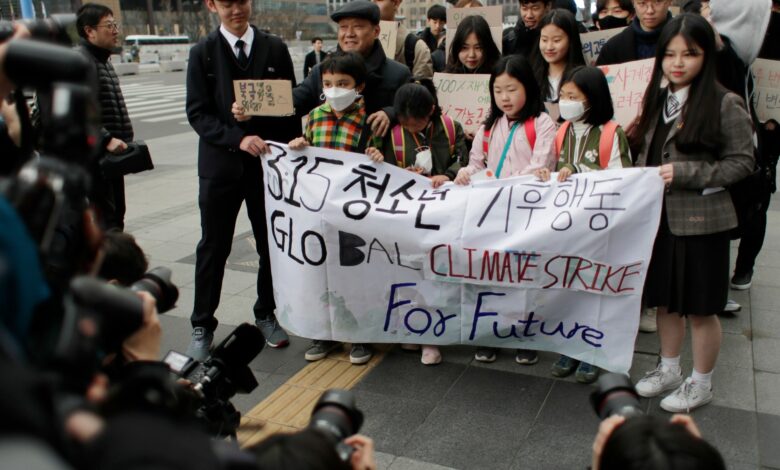Why are South Korean babies and children suing their government?

As a 20-week-old embryo, Choi Hee-woo became one of the world’s youngest-ever plaintiffs by joining a landmark climate lawsuit against South Korea.
In late May, South Korea’s Constitutional Court held a final hearing of the first case in East Asia to challenge national climate policies.
Now 18 months old, Hee-woo and more than 60 other children await a verdict that is expected later this year.
So what did their case challenge, and where does South Korea stand with its climate action?
What is the children’s climate case in South Korea?
South Korea’s Constitutional Court heard landmark cases alleging that the government is failing to protect people in the country from the harms of climate change.
Four similar climate cases filed between 2020 and 2023 were combined in February for procedural reasons. The first hearing of the joint case was held in April, while the second and last one was on May 21.
The petition involving Hee-woo was called “Woodpecker vs South Korea”, after his nickname in the womb. It was filed by about 200 people, including 62 children who are all under the age of five.
Another lawsuit in 2020 was filed by 19 youth activists.
Plaintiffs say that without stronger climate action, the government is failing to meet a constitutional obligation to protect people’s right to life and a healthy environment.
Under the 2015 Paris Agreement, South Korea has also made a legally binding international commitment to prevent average global temperatures from rising by more than 1.5 degrees Celsius (2.7 degrees Fahrenheit) this century.
Although the date of the verdict is unclear, a decision is expected later this year, according to Amnesty International.
What climate agreements has South Korea made?
Under South Korea’s Decree of the Carbon Neutrality Act, by 2030 the country must reduce its greenhouse gas emissions by 40 percent compared with levels in 2018, which amounts to a drop of 290 million tonnes.
This Nationally Determined Contribution, or NDC, is unique to each country and represents their commitment towards reducing global emissions according to the 2015 Paris Agreement.
Plaintiffs of the climate case argue that the current goal underestimates the amount of emissions South Korea needs to reduce to reign in global temperature increase.
Additionally, to meet their goal by 2030, the country would have to reduce emissions by 5.4 percent every year from 2023, a target they have so far failed to meet.
Prior to the cases being merged, three of them challenged the target level of emission reduction set in the NDC, while the fourth one argued that the implementation plan for it is inadequate.
South Korea also aims to achieve net zero emissions by 2050.
How does this impact climate action in South Korea?
The case’s conclusion is coming ahead of a deadline for countries to submit revised goals for reducing emissions.
Reviewed every five years under the Paris Agreement, the next set of targets will be presented by early 2025 and cover the following 10 years.
If the court rules in the favour of the plaintiffs, South Korea may have to be more ambitious in its next round of climate plans, experts told the journal Nature.
Where does South Korea’s climate action stand?
Currently, South Korea’s contribution to reducing emissions, or NDC, is categorised as “insufficient” by Climate Action Tracker, an independent scientific project that monitors how governments perform on their climate commitments.
In 2022, South Korea got only 5.4 percent of its energy from wind and solar, which is less than half the global average of 12 percent and far behind neighbouring Japan and China, according to energy think tank Ember.
Additionally, South Korea is the G20’s second-highest carbon emitter per person.
What other major climate cases have young people filed?
Several youth-led climate cases have been filed and have succeeded over the years.
In 2020, nine people between the ages of 15 and 32 challenged Germany’s Federal Climate Protection Act in the Federal Constitutional Court, claiming the law’s emission reduction targets were still insufficient and violated their human rights.
The following year, the court ruled in their favour, concluding that the country’s climate change mitigation plans were inadequate, pointing out that it could lead to “intergenerational injustice”.
In essence, the court concluded that Germans today are consuming too much of the carbon budget while contributing little to reduction efforts, leaving too much of a burden on future generations. The German government responded by advancing its timeline to reach carbon neutrality from 2050 to 2045.
In the United States in 2020, a group of 16 people aged five to 22 years old, sued the state of Montana, arguing it was not protecting their right to a clean environment. In 2023, the court ruled in their favour saying that Montana has to take climate change into account when approving fossil fuel projects.
Six youths between the ages of 11 and 24 also filed a lawsuit against 32 European countries in 2023, arguing that climate change threatens their rights to life, privacy and mental health. However, the European Court of Human Rights dismissed their case due to its broad geographic scope.



